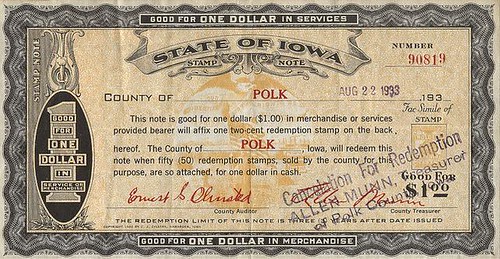
PREV ARTICLE
NEXT ARTICLE
FULL ISSUE
PREV FULL ISSUE
WALL STREET JOURNAL ON CALIFORNIA'S IOU'S AND THEIR PREDECESSORS Tom Sheehan noted that yesterday's edition of the Wall Street Journal had an article about the state of California's Treasury Warrants that did a nice job of reviewing the history of state and municipal scrip in the U.S. The online article has a link to a great slide show of different types of scrip. Check out the full version - E-Sylum reader Neil Shafer, author of the Standard Catalog of Depression Scrip of the United States is interviewed, as is Rod Charlton II, who DepressionScrip.com. -Editor To creditors of the state of California who got paid in IOUs instead of money, take it from historians -- things could be worse. You could be getting clamshells. Or chunks of plywood.During the Great Depression, hundreds of communities as strapped for cash as California is today circulated their own temporary currencies. An estimated $1 billion in this scrip was issued by towns and counties, not to mention corporations, school boards, newspapers and a few wealthy individuals. Most promissory notes looked like paper currency, but scrip was also printed on leather, metal, fish-skin parchment and, in Tenino, Wash., on slabs of two-ply Sitka Spruce.  Today, collectors treasure remnants of those desperate times: a green-and-gold "sauerkraut note" from Minneapolis; a warrant, beautifully printed with an engraving of a clipper ship, from Cape May County, N.J. Some imagine filling out their collection with Schwarzenegger scrip, circa 2009. "Every piece tells a story," says Neil Shafer, author of the "Standard Catalog of Depression Scrip of the United States," published in 1984. "It represents a piece of social history." Since California ran out of cash early this month, it has issued more than 194,000 IOUs, with a total value of $1.03 billion. They are redeemable in U.S. dollars on Oct. 2, or sooner if the state comes up with the money. The legislature on Friday approved a plan to close a $24 billion budget gap, but officials say it could still take a few weeks to analyze the state's cash situation and resume giving creditors checks instead of promises. California IOUs differ from Depression-era scrip in a key respect: They are made out to individual creditors for specific amounts. Scrip in the 1930s was designed to circulate like currency and usually issued in standard denominations: 25 cents, $1, $5. Issuance exploded in early 1933, as banks in city after city suspended operations in the face of runs on their teller windows, severely restricting the amount of money in circulation. On March 6, President Franklin D. Roosevelt shut down nearly all transactions in a "bank holiday," even as he prodded the Federal Reserve to hurry up and print more currency. Some banks reopened within days, but others remained shut for weeks. People and businesses ran out of cash. Some turned to barter. The New York Daily News, which was sponsoring a boxing match at Madison Square Garden, offered a ticket in exchange for any item worth 50 cents. Fans brought in spark plugs and nightgowns, frankfurters and jigsaw puzzles, New Testaments and noodles and golf knickers, says Mr. Shafer, who chronicled the era in his book. But barter goes only so far. Makeshift currencies soon were popping up everywhere. Each note of the funny money was supposed to be backed by the assets of the issuer. For the most part, the system worked: When the crisis passed, holders of scrip were able to redeem it for legal tender. Though a few issuers saved stashes of their scrip, and it now can be bought cheaply at online auction sites, many other issuers destroyed the notes after they were redeemed. With those bills, the few that survive can fetch hundreds of dollars. Rod Charlton II, who runs a Web site called DepressionScrip.com, says there is no bigger thrill than finding an unusual note online. "I can't sleep at night because I want to get hold of it so bad," he says. "It's that kind of obsession." California's IOUs lack the flair of much Depression-era scrip; they are basic, pale-green government-issue checks, except they bear the telltale label "Registered Warrant." Still, collectors say they would make good souvenirs of today's financial crisis. The trick will be getting hold of one. California plans to destroy the IOUs after they are redeemed. And state officials say they expect a high redemption rate. "The people who got them probably aren't sitting around thinking, 'I'm going to save this for posterity,' " says Mr. Gatch, the political scientist. "They're more likely thinking, 'How the hell am I going to cash this?' " Remember the saying, "Get 'em while they're hot?" Well, get 'em while they still exist. Museum curators - contact the state of California and ask for specimens for your collections. -Editor To read the complete article, see: Cash-Strapped California's IOUs: Just the Latest Sub for Dollars (online.wsj.com/article/SB124846739587579877.html) Wayne Homren, Editor The Numismatic Bibliomania Society is a non-profit organization promoting numismatic literature. See our web site at coinbooks.org. To submit items for publication in The E-Sylum, write to the Editor at this address: whomren@gmail.com To subscribe go to: https://my.binhost.com/lists/listinfo/esylum All Rights Reserved. NBS Home Page Contact the NBS webmaster 
|